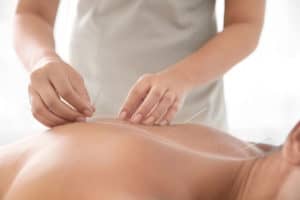Our new Silver Spring clinic offers dry needling to help manage your pain

January 16, 2019
There’s a fairly new trend that has been growing in popularity in the field of physical therapy that you may have heard or read about. The practice is called dry needling, which consists of applying very thin needles to specific locations in the body to alleviate pain. As an emerging treatment, the use of dry needling is still spreading and it is not yet a standard option at most physical therapy practices. But we’re proud to announce that our newest clinic in Silver Spring now offers dry needling services to better help manage whatever type of pain you may be dealing with.
Trigger point dry needling—or simply dry needling—may appear to be very similar to traditional Chinese acupuncture, but the two don’t actually share any historical ties. The similarities between dry needling and acupuncture start and end with the fact that both techniques insert the same type of thin filament needles into various muscles of the body. But acupuncture is used holistically to treat imbalances in the body, while dry needling targets knotted areas in the muscles called trigger points. When applied effectively, dry needling stimulates the tissue of any damaged muscles and “resets” them, which in turn reduces pain and restores normal function.
Here’s a closer look at how the dry needling process works:
- A thin, “dry” needle—meaning it has no medications on or in it—is inserted into a muscle; healthy muscles will produce little discomfort while sensitive ones with trigger points may react with a mild pain that’s similar to a muscle cramp
- With a needle placed in a trigger point, a “twitch response” will arise; this will be similar to the pain the patient normally experiences in that area
- This pain sensation usually indicates that the treatment is effective, and it will deactivate the trigger point
- Deactivating the trigger point will in turn “reset” that muscle; this will reduce pain and restore the muscle to its normal length and function
- Positive outcomes are typically noticed within 2-4 treatment sessions
Dry needling is not typically used as a standalone therapy. Instead, in most cases it serves as one component of a comprehensive physical therapy treatment program that may also include manual (hands-on) therapy, education, and various types of stretching and strengthening exercises. It has been found to be effective for both acute (initial) and chronic (long-term) pain from wide variety of conditions, such as neck and band pain, strains, sprains, headaches, overuse injuries, whiplash, tendinitis, hip and knee pain, muscle spasms, and repetitive stress disorders like carpal tunnel syndrome. Dry needling is also a very safe intervention that is associated with minimal side effects.
So if you have a painful condition that is not responding to other types of treatment, dry needling may be right for you, but the only way to know for certain is by undergoing a complete evaluation from one of our Silver Spring physical therapists. Contact CAM Physical Therapy and Wellness Services today at 301-853-0093 to schedule an appointment today at any of our four clinics in Hyattsville, Laurel, Glenn Dale/Bowie, or our newest location in Silver Spring, MD, or you can click here for more information on dry needling.